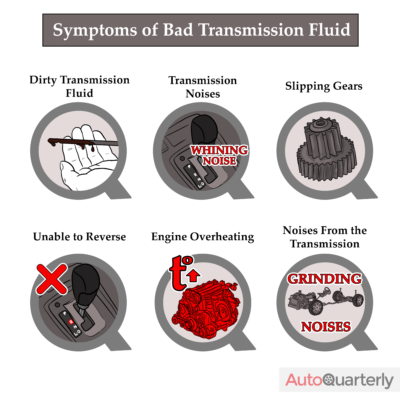Transmission fluid is an essential product that keeps your car’s engine running smoothly. Without any transmission fluid or with bad transmission fluid in your vehicle, you run the risk of damaging your engine or other vital components that may be costly, or even impossible, to repair.
If you suspect that your vehicle’s transmission fluid has seen better days, keep an eye out for the symptoms we discuss in this article. Later on, we’ll also be giving you information on the necessary steps to take once you’ve confirmed your transmission fluid is bad and the potential cost to fix up this issue.
Why Is Transmission Fluid Necessary?
While many individuals know that transmission fluid is important for your engine’s overall health and functioning, you may not know exactly what transmission fluid does in your vehicle. To start with, transmission fluid is what facilitates the transfer of power from the engine to the pavement, keeping your car moving; the fluid allows for the movement of rotational force between the engine and the transmission.
Additionally, transmission fluid will help to absorb heat produced by your car when it is running and expels this heat through your vehicle’s radiator. This cooling of the transmission is essential in keeping your engine in good health and stopping it from encountering the many negative consequences of overheating.
The lubrication powers of transmission fluid also allow it to enable all of your car’s internal components to run smoothly. Without enough transmission fluid being present or with bad transmission fluid, these components can wear on each other and rapidly degrade to a point where repair is incredibly costly or impossible.
Symptoms of Bad Transmission Fluid
The below symptoms can indicate that your transmission fluid is bad. Continuing to drive your car while it has bad transmission fluid may result in a number of negative consequences and can degrade your vehicle’s engine.
Dirty Transmission Fluid
One of the easiest and most common ways to check whether or not your transmission fluid is bad is to look at the quality of the fluid. In automatic transmissions, you will need to pull the dipstick out of the transmission, wipe it off, and then re-dip it. From there, check the level and the color of the fluid.
Transmission fluid that is still good will be clear or slightly pink colored. Old or bad transmission fluid will be deep red or brown, and it may also contain small amounts of debris in it. If the fluid is a very dark brown, this may mean the fluid is burnt and your engine is at risk for overheating.
It can be a little more in-depth to check your transmission fluid quality in manual cars – you can read more about this process here.
Transmission Noises
A whining noise coming from your transmission can indicate that there is a clogged fluid line or a problem with the torque converter. Either of these things can be serious problems, so if you start to hear loud whining noises when your car is in reverse or when you are moving forward, you may want to consult a professional about your transmission issues as soon as possible.
Slipping Gears
Transmission fluid is designed to keep your car moving and ensure the transfer of power through your vehicle. When your transmission fluid is bad, it can cause a lack of hydraulic power which may result in gears slipping. There may also not be enough pressure to keep the gears functioning normally, as dirty transmission fluid does not flow properly through your engine.
Unable to Reverse
If your transmission fluid is bad or far too dirty, it won’t be able to flow properly. This can stop your car from being able to switch into reverse. However, there can be several other reasons why your car won’t move in reverse, so be sure to take note of any other symptoms you are experiencing with your vehicle to get the proper diagnosis.
Engine Overheating
Because transmission fluid also helps to cool down your engine’s temperature, you may experience your engine running too hot or overheating as a result of bad transmission fluid. This is because dirty or old transmission won’t flow as smoothly as it should, leaving internal components of your car rubbing against each other and not entering into the car’s cooling tank properly.
Very burnt looking transmission fluid in addition to engine overheating issues can indicate that your transmission fluid needs to be replaced as soon as possible.
Grinding Noises From the Transmission
If your transmission fluid is too old or dirty, it won’t properly flow through the internal components of your engine. This can leave things grinding against each other and may create a loud noise as you drive your vehicle. When you hear these grinding noises, you should immediately check your transmission fluid levels and color, and considering taking your car to a professional for a full evaluation.
How to Fix Bad Transmission Fluid
If you have one or more of the symptoms of bad transmission fluid, you may be wondering what you can do about it. In most cases, it is best to seek out a professional’s opinion and tell them about the symptoms you are experiencing. From there, the mechanic can fully evaluate and diagnoses your problem, providing you with solutions.
For most people, the answer to bad transmission fluid will be a simple flush or change (a flush replaces all of the fluid and a change only replaces some of the fluid) and a fluid top-up. However, if you have had bad transmission fluid for a long time, you may have other issues in the engine that need replacing or repairing to put a stop to any symptoms. This can become quite costly, so be sure to address your vehicle’s issues as soon as possible after noticing that something is wrong in order to prevent extreme damage and repair costs.
The Cost of Transmission Fluid Replacement
Overall, a transmission fluid change is not the most expensive car repair out there. In general, a change will cost you between $100 and $500 (including labor and quarts of fluid), depending on the fluid’s condition and how much fluid you need to be added into your vehicle.
A full transmission flush (replacing all of the fluid) may cost you more than a simple transmission fluid change, and you may also end up paying more for a dealer to complete this repair than you would with a local mechanic.
Can You Change Transmission Fluid Yourself?
It is possible to change your transmission fluid by yourself, but you may need a little bit of DIY knowledge about cars to achieve this. Changing your own transmission fluid can save you on repairs costs, as it will only be about $50 to $150 for this process, not counting your own time as labor. If you want to give this process a try, you can read more about the steps here.
Can You Drive a Car With Bad Transmission Fluid?
For the most part, you should not be driving a car with bad transmission fluid. This is because the longer you keep dirty or old transmission fluid moving in your car, the greater the risk there is for internal components wearing against each other or your engine overheating completely. It may also decrease the life of your engine and put unnecessary strain on your car over time.
The best plan of action is to take your car to a professional for a full diagnosis as soon as you start to experience any of the symptoms we discussed above. This will help you to fix up the issue before it becomes more costly and stressful than it needs to.
Keeping Your Car Running Safely
Transmission fluid is an essential part of your engine that helps to keep your car running and prevents the engine from experiencing overheating or extreme wear and tear. When your transmission fluid becomes too old or too dirty, it stops being able to perform its essential functions, leading to a number of unpleasant symptoms and eventually degrading your engine.
If you believe you have bad transmission fluid, make an effort to take your vehicle to a professional as soon as possible for a proper diagnosis and to get the issue fixed before it grows out of hand.



